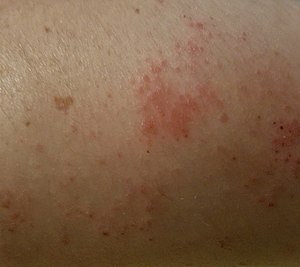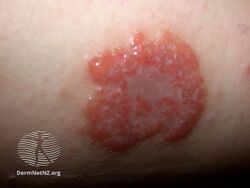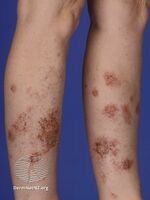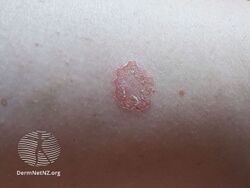Nummular dermatitis
| Nummular dermatitis | |
|---|---|
| Other names: Discoid dermatitis, Discoid eczema, Microbial eczema, Nummular eczema, Nummular neurodermatitis | |
 | |
| Lesions visible on outer thigh | |
| Specialty | Dermatology |
| Differential diagnosis | Dermatophytosis (Ringworm) |
Nummular dermatitis is one of the many forms of dermatitis.[1] it is characterized by round or oval-shaped itchy lesions.[2] The name comes from the Latin word "nummus," which means "coin."
Signs and symptoms
Nummular dermatitis is characterized by chronic or relapsing itchy coin-sized ovoid-shaped red plaques.[3][4] They can occur on the trunk, limbs, face, and hands.[1][2][5]
-
Discoid eczema
-
Discoid eczema
-
Discoid eczema day 14
Causes
Many contact sensitizers or irritants are known to cause contact dermatitis superimposed on nummular dermatitis. Studies have implicated nickel, cobalt, chromate, and fragrance as likely culprits.[6][7] Xerosis, or dehydration of skin is also a likely cause.[8] Infection with Staphylococcus aureus bacteria or Candida albicans may also play a role.[8]
Diagnosis
Diagnosis of nummular dermatitis is largely via clinical observation. Biopsies are typically not necessary, and cannot be used to rule out other atopic dermatitis or other eczemas.[9][10] However, patch testing may be employed to rule out irritants (contact dermatitis) as a cause.[6][11] In children, nummular dermatitis is commonly confused with tinea corporis.[8]
Treatment
One of the keys to treatment and prevention involves keeping the skin moisturized. Lotions, creams, and bath oils may help prevent an outbreak. If the condition flares up, a common treatment involves the application of topical corticosteroids. Oral antihistamines may help lessen itching. Avoidance of irritants is a common strategy. More severe cases sometimes respond to ultraviolet light treatment. If the condition occurs only during the sun-less winter months then vitamin D supplement might be an effective treatment.[citation needed]
Epidemiology
The prevalence of nummular dermatitis in the United States is approximately 2 per 1,000.[12] It is considered a disease of adulthood, for it is rare in children.[13]
See also
References
- ↑ 1.0 1.1 Cowan, M. A. (1961-01-01). "Nummular eczema. A review, follow-up and analysis of a series of 325 cases". Acta Dermato-Venereologica. 41: 453–460. ISSN 0001-5555. PMID 13881857.
- ↑ 2.0 2.1 WEIDMAN, ABRAHAM I. (1956-01-01). "Nummular Eczema". AMA Archives of Dermatology. 73 (1): 58–65. doi:10.1001/archderm.1956.01550010060006. ISSN 0096-5359. PMID 13275125. Archived from the original on 2017-04-02. Retrieved 2017-04-01.
- ↑ ADACHIA, A (2000). "Mercury-induced nummular dermatitis". Journal of the American Academy of Dermatology. 43 (2): 383–385. doi:10.1067/mjd.2000.102457.
- ↑ Rollins, Troy G. (1968-10-14). "From Xerosis to Nummular Dermatitis: The Dehydration Dermatosis". JAMA. 206 (3): 637. doi:10.1001/jama.1968.03150030093022. ISSN 0098-7484. PMID 5695586.
- ↑ Perry, Adam D.; Trafeli, John P. (2009-05-01). "Hand Dermatitis: Review of Etiology, Diagnosis, and Treatment". The Journal of the American Board of Family Medicine. 22 (3): 325–330. doi:10.3122/jabfm.2009.03.080118. ISSN 1557-2625. PMID 19429739.
- ↑ 6.0 6.1 Khurana, Sandeep; Jain, V. K.; Aggarwal, Kamal; Gupta, Sanjeev (2002-12-01). "Patch testing in discoid eczema". The Journal of Dermatology. 29 (12): 763–767. doi:10.1111/j.1346-8138.2002.tb00219.x. ISSN 0385-2407. PMID 12532040.
- ↑ Bonamonte, Domenico; Foti, Caterina; Vestita, Michelangelo; Ranieri, Luigi Davide; Angelini, Gianni (2012). "Nummular Eczema and Contact Allergy". Dermatitis. 23 (4): 153–157. doi:10.1097/der.0b013e318260d5a0. PMID 22828253. Archived from the original on 2019-12-11. Retrieved 2017-04-01.
- ↑ 8.0 8.1 8.2 Williams, Hywel C. (2005-06-02). "Atopic Dermatitis". New England Journal of Medicine. 352 (22): 2314–2324. doi:10.1056/NEJMcp042803. ISSN 0028-4793. PMID 15930422.
- ↑ Kulthanan, Kanokvalai; Samutrapong, Pailin; Jiamton, Sukhum; Tuchinda, Papapit (2007-12-01). "Adult-onset atopic dermatitis: a cross-sectional study of natural history and clinical manifestation". Asian Pacific Journal of Allergy and Immunology. 25 (4): 207–214. ISSN 0125-877X. PMID 18402293.
- ↑ Julián-Gónzalez, Rolando Elias; Orozco-Covarrubias, Luz; Durán-McKinster, Carola; Palacios-Lopez, Carolina; Ruiz-Maldonado, Ramon; Sáez-de-Ocariz, Marimar (2012-09-01). "Less common clinical manifestations of atopic dermatitis: prevalence by age". Pediatric Dermatology. 29 (5): 580–583. doi:10.1111/j.1525-1470.2012.01739.x. ISSN 1525-1470. PMID 22469300.
- ↑ Krupa Shankar, D. S.; Shrestha, Shristi (2005-11-01). "Relevance of patch testing in patients with nummular dermatitis" (PDF). Indian Journal of Dermatology, Venereology and Leprology. 71 (6): 406–408. doi:10.4103/0378-6323.18945. ISSN 0378-6323. PMID 16394482. Archived (PDF) from the original on 2020-09-30. Retrieved 2019-09-05.
- ↑ T., Johnson, Marie Louise (1977-01-01). "Prevalence of dermatological disease among persons 1-74 years of age: United States". ADV Data Natl CTR Health Statistics. Archived from the original on 2017-04-02. Retrieved 2017-04-01.
- ↑ Krol, Alfons; Krafchik, Bernice (2006-03-01). "The differential diagnosis of atopic dermatitis in childhood". Dermatologic Therapy. 19 (2): 73–82. doi:10.1111/j.1529-8019.2006.00058.x. ISSN 1529-8019. PMID 16669989.
External links
| Classification | |
|---|---|
| External resources |


